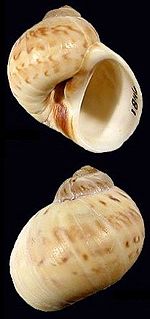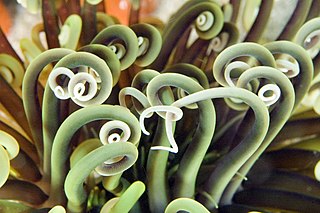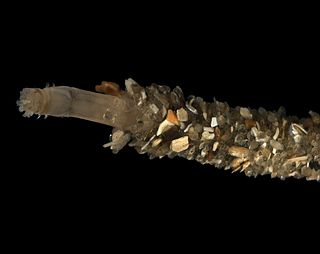
Nereis is a genus of polychaete worms in the family Nereididae. It comprises many species, most of which are marine. Nereis possess setae and parapodia for locomotion. They may have two types of setae, which are found on the parapodia. Acicular setae provide support. Locomotor chaetae are for crawling, and are the bristles that are visible on the exterior of the Polychaeta. They are cylindrical in shape, found in sandy areas, and they are adapted to burrow.

Tube-dwelling anemones or ceriantharians look very similar to sea anemones but belong to an entirely different subclass of anthozoans. They are solitary, living buried in soft sediments. Tube anemones live inside and can withdraw into tubes, which are composed of a fibrous material made from secreted mucus and threads of nematocyst-like organelles known as ptychocysts. Ceriantharians were formerly classified in the taxon Ceriantipatharia along with the black corals but have since been moved to their own subclass, Ceriantharia.

Octopus is the largest genus of octopuses, comprising more than 100 species. These species are widespread throughout the world's oceans. Many species formerly placed in the genus Octopus are now assigned to other genera within the family Octopodidae.

Scaeurgus is a genus of octopuses in the family Octopodidae.
Paludinella is a genus of minute salt marsh snails with an operculum, aquatic gastropod mollusks or micromollusks, in the family Assimineidae.

Pleurobranchus is a genus of sea slugs, specifically side-gill slugs, marine gastropod mollusc in the family Pleurobranchidae.

Euspira nitida is a species of sea snail, a marine gastropod mollusc in the family Naticidae, the moon snails.

Raphitoma leufroyi is a species of sea snail, a marine gastropod mollusk in the family Raphitomidae.

Spurilla is a genus of sea slugs, aeolid nudibranchs, marine gastropod mollusks in the family Aeolidiidae.

Agalmatidae, or Agalmidae, is a family of siphonophores.

Janolus cristatus, sometimes known by the common name crested aeolis, is a species of nudibranch, a marine gastropod mollusk in the family Proctonotidae.

Spurilla neapolitana, the Neapolitan spurilla, is a species of sea slug, an aeolid nudibranch, a marine gastropod mollusk in the family Aeolidiidae. It is native to the western Atlantic Ocean, the Caribbean Sea and the Mediterranean Sea. This species was first described as Eolis neapolitana by the Italian naturalist Stefano delle Chiaje in 1841. However, although some authorities quote the year as 1823, the species does not appear in the first volume of delle Chiaje's memoirs, which was published that year. The species was later reassigned to the genus Spurilla.

Cerianthidae is a family of tube-dwelling anemones in the order Spirularia of the subclass Ceriantharia.
Distomus is a genus of ascidian tunicates in the family Styelidae.

Terebellides is a genus of polychaete worms in the family Terebellidae. Terebellides sepultura is named after the Brazilian heavy metal band Sepultura.
Mangelia neapolitana is a species of sea snail, a marine gastropod mollusk in the family Mangeliidae, the cone snails and their allies.














